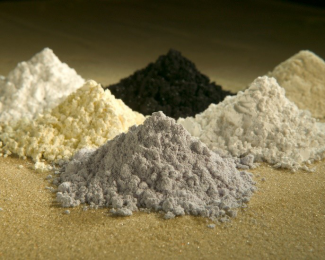 NETL’s Mary Anne Alvin sees a brighter future ahead for the nation’s energy communities that have powered the nation for more than a century as the U.S. undergoes a historic transformation to clean energy.
NETL’s Mary Anne Alvin sees a brighter future ahead for the nation’s energy communities that have powered the nation for more than a century as the U.S. undergoes a historic transformation to clean energy.
Alvin’s optimism is rooted in the fact that residual and waste byproducts, such as power plant ash and acid mine drainage, are prime sources to obtain rare earth elements (REEs) and critical minerals (CMs), vital materials used to manufacture consumer products such as smartphones, batteries for hybrid and electric vehicles, computer monitors and hard drives, high-performance optics and lasers, powerful magnets and components for defense systems.
REEs and CMs from those sources also are needed to produce key components for windmills, solar panels and other green energy equipment to achieve the Biden Administration’s goal of a net-zero carbon emission electricity sector by 2035 and the broader economy by 2050.
Other factors are at play that position these domestic resources in a new critical role to directly support U.S. economic and national security.
The U.S. currently imports approximately 80% of its REEs directly from China, with portions of the remainder indirectly sourced from China through other countries.
By using domestic resources to create a sustainable CM and REE supply chain, the U.S. will reduce its risk of supply disruption for essential domestic and military industries while producing needed materials for the emerging clean energy technology market. The current $5 billion global REE market is projected to grow 40% in the next five years, with similar growth anticipated for the CM market.
“Through the creation of our own sustainable supply, the U.S. not only reduces risk of supply disruption for essential domestic and military industries, it also creates materials for new high-tech, clean energy manufacturing jobs and restores environmentally scarred lands as useful areas,” said Alvin, whose responsibilities for NETL include validating the technical and economic feasibility for extracting, separating and recovering REEs and CMs from unconventional domestic resources using conventional and advanced separation systems.
Days after taking office, President Biden signed Executive Order 14008, Tackling the Climate Crisis at Home and Abroad, establishing an Interagency Working Group (IWG) on Coal and Power Plant Communities and Economic Revitalization. The purpose of the IWG is to promote development of good-paying union jobs in clean energy industries in communities already impacted by power plant closures and those likely to be impacted by additional declines in industry.
“State-of-the-art technology to extract, separate and process REEs and CMs from domestic resources offers solutions to meet those goals and others,” Alvin said.
NETL has partnered with top research universities and industry to develop technologies to capture REEs and CMs from carbon-based power generation waste byproducts.
Means of extracting REEs and CMs via physical beneficiation processes and extractive hydrometallury or acid leaching processes have produced positive results. NETL remains committed to exploring these and all available avenues. Several examples illustrating NETL’s success in REE and CM separation and recovery include:
- NETL is working closely with the University of Kentucky and its subcontractors, the University of Utah, Virginia Tech, Alliance Resource Partners and Blackhawk Mining, to demonstrate novel processes that could transform energy communities into new suppliers of REEs and CMs. These researchers are using dual X-ray transmission sorter equipment for separation of carbon ore refuse into fractions that contain potentially high concentrations of REEs.
To significantly reduce the primary cost of producing the concentrates, naturally occurring pyrite in carbon ore is being recovered and used in bioreactors to generate the acid needed for leaching. To assess the technical and economic potential of extracting REEs from carbon ore waste, a quarter-ton per hour modular pilot facility was designed, constructed and is being operated as part of ongoing projects funded by the U.S. Department of Energy (DOE). The pilot project is one of three (soon to be five) first-of-a-kind facilities in the U.S. producing small quantities of high-purity REEs and CMs from domestic resources.
- NETL is collaborating with Physical Sciences Inc., the University of Kentucky’s Center for Applied Energy Research and Winner Water Services to investigate recovery of REEs and CMs, including yttrium and scandium (REYSc), from power plant ash.
The team conducted feasibility and technoeconomic studies for recovery of REYSc from the ash and designed and constructed a small pilot-scale facility to produce salable REYSc-rich concentrates and commercially viable co-products, including CMs such as aluminum, from ash feedstock using environmentally safe and high-yield physical and chemical enrichment and recovery processes.
The pilot plant at Winner Water Services in Sharon, Pennsylvania, is operating at a scale of approximately 0.4-1 tonne per day (tpd) ash throughput for physical processing and about 0.5 tpd for chemical processing. The project team has successfully produced REYSc concentrates at greater than 50% purity, in addition to CMs.
- NETL partners at the West Virginia University Research Institute’s Rare Earth Extraction Facility designed, constructed and commissioned a bench-scale project and recently a pilot facility to recover both REEs and CMs from acid mine drainage (AMD) fluids and sludge precipitates from mining sites.
Project partners from the West Virginia Department of Environmental Protection, Rockwell Automation Inc. and Virginia Tech will use the pilot facility to treat up to 1,000 gallons per minute of AMD while producing an enriched REE and CM (e.g., cobalt) concentrate.
WVU estimates that based on the volume of AMD generated in Pennsylvania and West Virginia, AMD sludges could yield 610 to 2,700 tonnes of REEs per year.
- Another NETL partner, the University of North Dakota, in a collaboration that includes Barr Engineering, Minnkota Power, the North Dakota Geological Survey and Rare Earth Salts, have designed and are finalizing construction of a pilot facility for continuous REE and CM extraction from North Dakota feedstocks. The pilot is capable of using a minimum 0.5 tonnes per hour feed rate of physically beneficiated lignite.
- NETL also has partnered with Battelle Memorial Institute (BMI) and Rare Earth Salts to advance the development and validation of BMI’s acid digestion process, along with Rare Earth’s novel electrowinning separation and purification process. BMI and Rare Earth successfully delivered an individually separated sample of lanthanum oxide from an unconventional resource with a purity of approximately 90%, rendering the material suitable for further processing into a pure metal form for subsequent incorporation into commodity or national defense products.
NETL continues to advance these technologies and others to extract and recover REEs and CMs from other domestic resources, including clay and sandstone over/under burden materials and legacy ash ponds. NETL is also beginning to address REE and CM recovery from resources such as mineral/metal acidic mine drainage, placer sand deposits (natural accumulations of heavy minerals in sediments in a stream or beach and in river gravel), phosphate mine materials, bauxite legacy impoundment materials, biomass, and more.
Visit the DOE-NETL Critical Minerals Sustainability Program website for more information about successful innovative projects the Lab has advanced to produce REEs and CMs needed to sustain and grow American manufacturing and industry.
The U.S. Department of Energy’s National Energy Technology Laboratory develops and commercializes advanced technologies that provide clean energy while safeguarding the environment. NETL’s work supports DOE’s mission to ensure America’s security and prosperity by addressing its energy and environmental challenges through transformative science and technology solutions.





 NETL’s Mary Anne Alvin sees a brighter future ahead for the nation’s energy communities that have powered the nation for more than a century as the U.S. undergoes a historic transformation to clean energy.
NETL’s Mary Anne Alvin sees a brighter future ahead for the nation’s energy communities that have powered the nation for more than a century as the U.S. undergoes a historic transformation to clean energy.